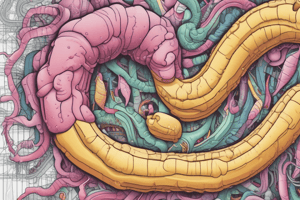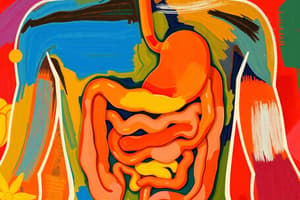Podcast
Questions and Answers
What is the main function of the large intestine?
What is the main function of the large intestine?
- Stores vitamins and minerals
- Absorbs nutrients and glucose
- Produces digestive enzymes
- Absorbs water and transforms waste into stool (correct)
What process describes the transportation and use of absorbed nutrients in the body?
What process describes the transportation and use of absorbed nutrients in the body?
- Metabolism
- Absorption
- Digestion
- Assimilation (correct)
Which statement about proteins is accurate?
Which statement about proteins is accurate?
- Proteins are stored as glycogen in the liver
- Proteins directly fuel energy production
- Proteins are broken down into simple sugars for energy
- Proteins are converted to amino acids for body repair (correct)
What is the primary role of digestive enzymes?
What is the primary role of digestive enzymes?
Which phase is NOT part of interphase?
Which phase is NOT part of interphase?
Mitosis is primarily associated with which of the following?
Mitosis is primarily associated with which of the following?
Which of the following occurs during prophase?
Which of the following occurs during prophase?
What happens in the synthesis (S) phase of the cell cycle?
What happens in the synthesis (S) phase of the cell cycle?
What is the primary role of bile produced by the liver in digestion?
What is the primary role of bile produced by the liver in digestion?
Which organ is responsible for absorbing the majority of nutrients from digested food?
Which organ is responsible for absorbing the majority of nutrients from digested food?
During which stage of digestion are enzymes primarily involved?
During which stage of digestion are enzymes primarily involved?
What prevents food from entering the windpipe during swallowing?
What prevents food from entering the windpipe during swallowing?
What is chyme?
What is chyme?
Which part of the gastrointestinal tract is responsible for moving waste products toward excretion?
Which part of the gastrointestinal tract is responsible for moving waste products toward excretion?
What initiates the process of peristalsis after food is swallowed?
What initiates the process of peristalsis after food is swallowed?
What is the primary function of gut bacteria in the gastrointestinal tract?
What is the primary function of gut bacteria in the gastrointestinal tract?
Flashcards are hidden until you start studying
Study Notes
The Digestive System
- The digestive system is comprised of the gastrointestinal tract (mouth, esophagus, stomach, small intestine, large intestine, and rectum), liver, pancreas, and gallbladder.
- Bacteria in the gastrointestinal tract (gut flora or microbiome) play a crucial role in digestion.
- Digestion breaks down food into smaller molecules for absorption.
- Mechanical digestion, like chewing, breaks food into smaller pieces.
- Chemical digestion employs digestive enzymes to further break down food.
- Peristalsis is the wave-like muscle contractions that push food through the digestive tract.
- The small intestine absorbs water and digested nutrients into the bloodstream.
- The large intestine absorbs water and converts liquid waste into stool.
- Assimilation is the process of transporting and utilizing absorbed nutrients.
- Digestive enzymes are proteins that catalyze chemical reactions, breaking down nutrients for absorption.
Cell Division
- Cell division occurs for growth, repair, and reproduction in organisms.
- Meiosis is cell division for sexual reproduction.
- Mitosis is cell division for growth and cell replacement.
- The cell cycle alternates between phases of division and rest.
- The interphase is the non-dividing stage of the cell cycle, characterized by:
- G1 phase: cell growth and development.
- S phase: DNA replication and chromosome duplication.
- G2 phase: further growth and preparation for division.
- Mitosis includes four stages:
- Prophase: chromosomes condense, nuclear membrane disappears, spindle fibers form.
- Metaphase: chromosomes line up at the center of the cell.
- Anaphase: sister chromatids separate and move to opposite poles.
- Telophase: chromosomes reach the poles, nuclear membranes re-form, and the cell divides.
Studying That Suits You
Use AI to generate personalized quizzes and flashcards to suit your learning preferences.




